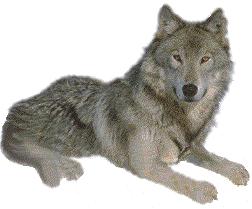|
BIG BAD WOLF, MY ASS: Info on the Grey Wolf |
|
|
Once divided up into over 30 different subspecies, now just five is the official number. This is due to similarities between types, as well as extinction. These different types are determined due to location, size, habits, and coloring. Select the name to find out more about the subspecies: Arctic Wolf
Specific Grey wolf related links: All About the Grey Wolves of Yellowstone
|
The Grey Wolf: Shadow In The Night technical-schmecknical name: Canis Lupus territory: Grey wolves. More well-known than the red wolf, and not as rare. Unfortunately, the territory of the Grey wolf is down to 2/3's what is was before. Most grey wolves dwell in the Northern US and Alaska, as well as in many Canadian places. They also, now, are virtually extinct in Europe, (minus some conservation attempts in Spain and other countries) although they used to have free range and populated all over the world. The Indian wolf, Japanese wolf, Newfoundland wolf and Texas Grey Wolf are some other completely extinct types. Wolves have been eradicated from much of their primary living areas, as wolves are not as adaptable to human intervention and colonization as their cousins, the fox and the coyote, are. Once, wolves occupied every area from Mexico to northern Canada. Now, they occupy less than 1% of their former territory in the United States. Particular wolves have a set territory that they protect and defend that they establish by marking it with their scents. hunting: Wolves need large herds of bison, ox, elk, white-tailed deer, and other hoofed mammals to prey on. They prey primarily on the sick or elderly animals, and work to keep the herds of ungulates strong and concentrated. However, when the big herds they prey on are not readily available, Grey wolves supplement their diet by preying on smaller animals, like those usually preyed upon by the Red wolf. Wolves do not eat every day, as they can not be expected to make a large kill for whatever reason given the rarity of their prey. When they do make a kill, they eat all they can--sometimes up to 15 lbs of flesh, because they may not eat the next day. Wolves divide most of their time between hunting and sleeping. The rest of their time goes to tending to the wolf puppies, washing and howling. As relatively clean animals, wolves will usually bathe in a lake or stream after a big kill or feeding frenzy. After a hunt, the alpha pair will eat first, and lower ranking members of the pack will eat only after the alpha male and female have had their share. The wolves then will venture back to the den where the wolf cubs are waiting for them to return. They will regurgitate some of their extra food for the cubs to eat. Any excess left over will then be stored for the future. reproduction: Puppies are born depending on the food supply--while usually the alpha pair will be the ones to have the only litter of cubs, sometimes, for whatever reason, a different female will give birth in the pack. If there is a lot of prey in excess, several litters may be born per season. Pups are born with dark grayish/black fur and blue eyes. They can't hear or see for several days after birth, and have very weak senses. Wolf pups have a very slim chance of actually surviving, however. In times of low food supply, only the strongest of the pups will survive. The puppies usually remain with their birthplace pack for about a year. After this point, most of the pups will disperse from the pack, usually meeting up with another dispersed grown pup of the opposite gender to form a new pack, or joining another pack already functioning. Sometimes, the weakest pup will stay with its original pack, becoming the omega. physical characteristics: These particular wolves are bigger than their Red wolf counterpart, weighing in at between 50-120 lbs. They can range in color, and can be white, grey, cream, black, or even combinations thereof. the pack: The pack is like a big family that works and plays together. A pack can consist of up to 30 individual wolves, but usually only consists of about 10 or under. All adults keep an eye on the pups, and everyone plays and howls together. The hierarchy (which you know: alpha pair at the top, beta follows, omega at the bottom) is intricate, and sometimes wolves will try to "overthrow" the alpha. Fights usually just consist of a lot of bluffing--the two contenders just buff up and make themselves look bigger until one of them gets scared at backs down. Everyone should be familiar with dominant stances and submissive stances: the alpha pair carries their tails the highest, everyone else's is lower. Tail between legs, ears back, body lowered all are submissive stances, usually displayed by lower-ranking wolves when in immediate presence of the alphas. Should the alpha be killed, the beta will take over. As for other packs, wolves do not take kindly to outside packs. Intruders on the packs' territory will be eradicated by whatever means necessary, and opposing packs will sometimes fight, occasionally resulting in death.
|
